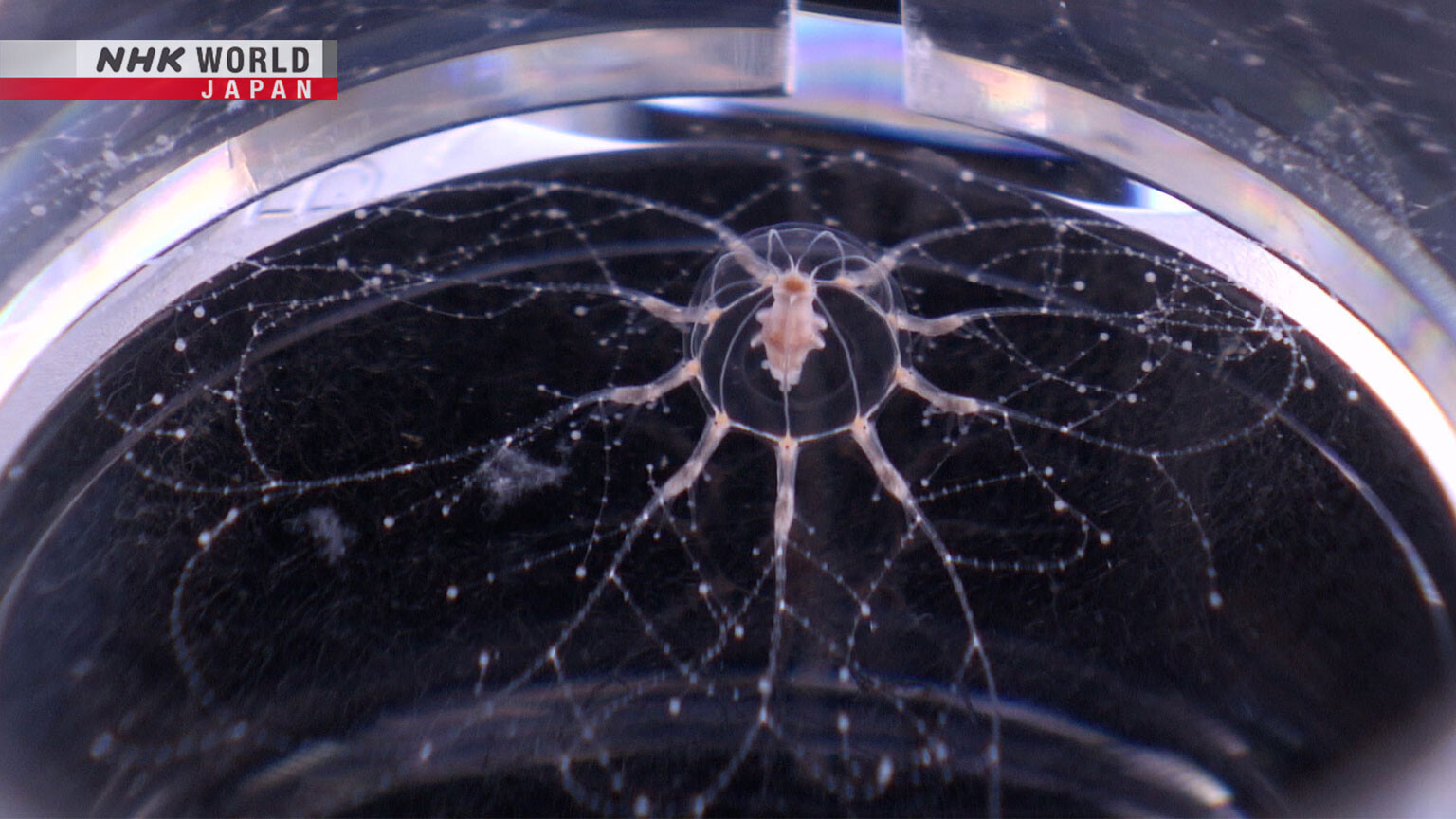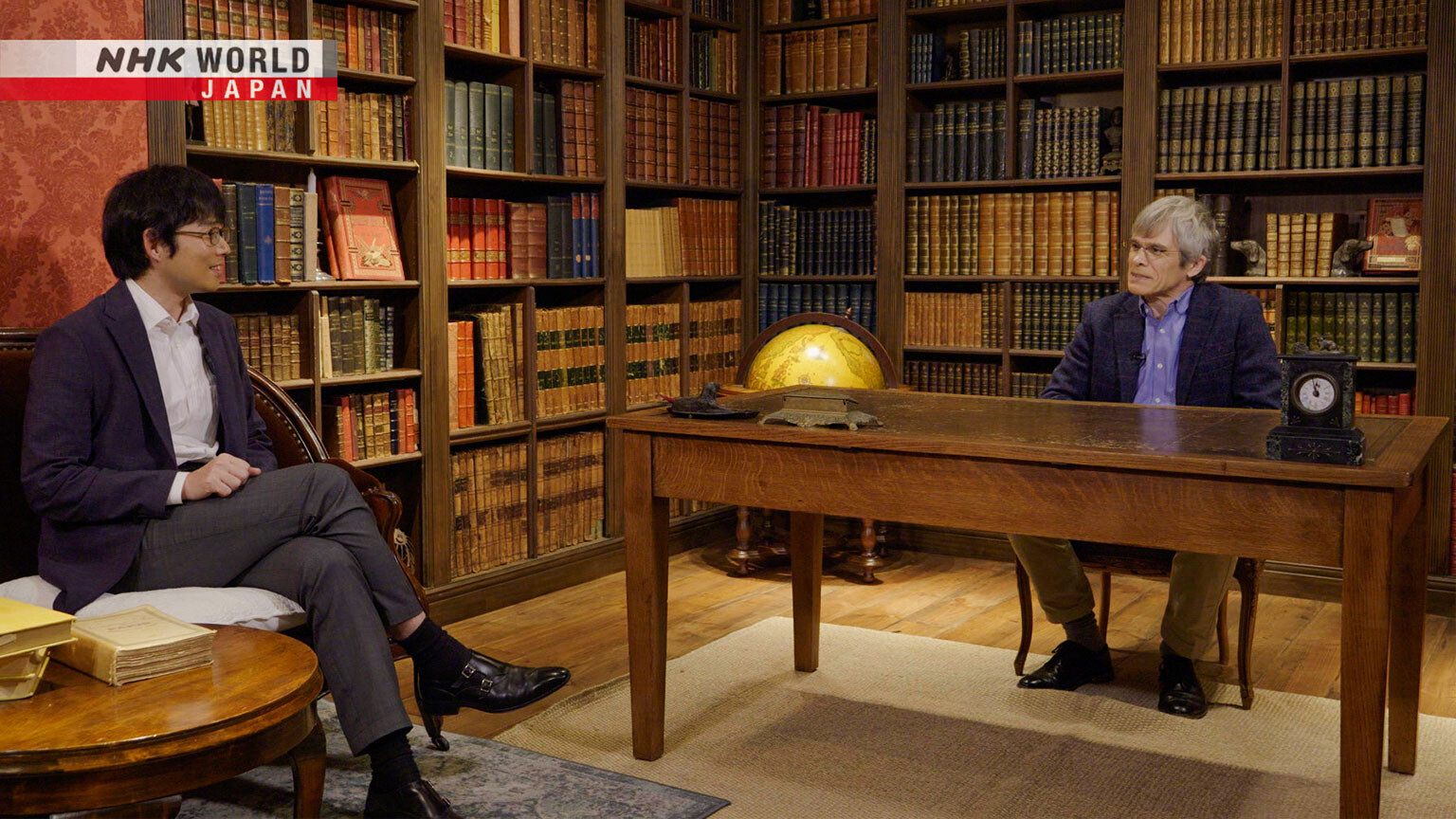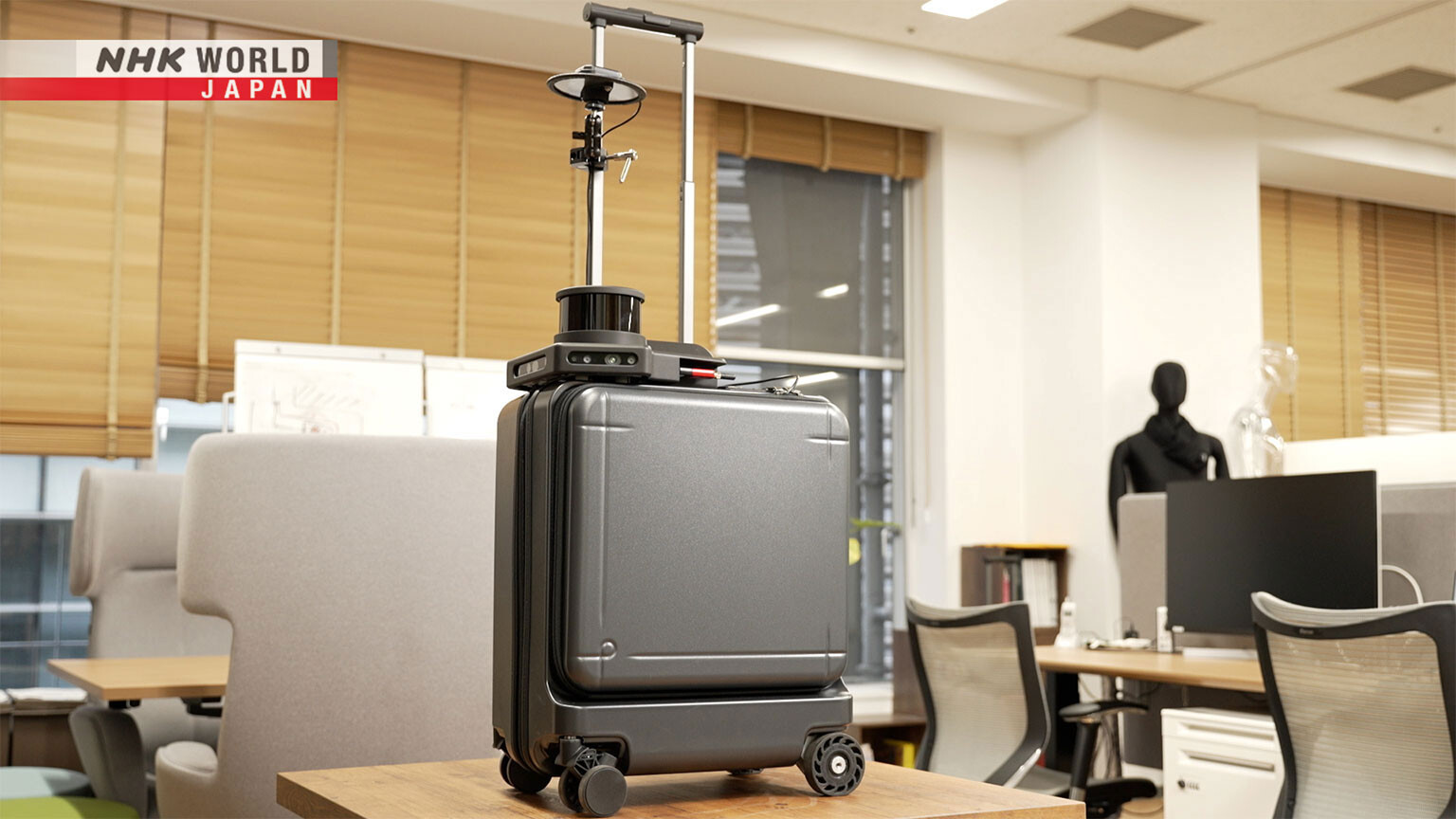The Ultimate Mystery: Delving into the World of Animal Sleep
All animals need sleep. Explore why and how it evolved. Also meet the developer of the AI Suitcase that helps the visually impaired walk more freely.




Transcript
Oh, I'm sorry about that.
I was so engrossed in writing the paper last night that I didn't notice how late it was getting.
And it just so happens that today's theme is sleep!
It's not just us humans.
Sleep seems to be something that animals need as well.
But have you ever considered why?
What is it about sleep that animals need?
In the long process of evolution, when did our ancestors start to sleep?
Today, we're going to be looking at sleeping and its mysteries.
There's a cat taking a nap.
Ahh, doesn't that feel good?
Did you know that giraffes sleep with their necks bent?
Living creatures have so many different ways to sleep.
On today's Science View, we'll focus on the mechanisms of sleep that researchers are now waking up to!
First, let's take a look at some unique ways living creatures sleep.
This is a bullethead parrotfish.
During the day, it feeds on algae and other organisms that grow on coral.
And at night...
Hmm... It's wrapped in a slimy bubble.
Shining light on it doesn't make the fish move.
It seems to be sleeping.
The substance is mucus produced by the parrotfish.
It's used like a sleeping bag to protect them from predators and parasites while asleep.
Next, let's look at the northern elephant seal.
In recent years, research has shown that they sleep in surprising ways.
For 7 months out of the year, they swim around in search of food.
The seals spend up to 20 hours a day foraging and eating.
It is said that they get roughly 2 hours of sleep per day underwater.
The environment is full of danger such as killer whales and sharks.
Researchers found that they dive to the depths between 100 to 300 meters,
where it's difficult for predators to pursue, and sleep while sinking.
Each sleep lasts about 10 minutes, which is repeated several times, resulting in a total of about 2 hours.
In contrast, during their 5 months of breeding season, the seals sleep on land for up to 10 hours a day.
As it's rare for animals to have 2 distinct sleeping patterns,
the northern elephant seals are attracting attention.
Sleeping leaves you vulnerable,
but animals find ways in which to protect themselves whilst not giving up on their slumbers.
And to help us understand why this should be, we've invited a guest today,
Yu Hayashi who works at both Tsukuba and Tokyo universities,
who will help us understand why this might be.
Prof. Hayashi, welcome!
Thanks for having me.
Sleep seems to be as important as protecting yourself.
Experts believe that no animal can live without sleep.
Yet, it could pose lots of danger like being attacked by predators.
In the long history of evolution,
I wouldn't be surprised to see animals that evolved to not need any sleep.
As you say, sleep is a risky behavior
so it's plausible that eliminating sleep could be advantageous.
However, in studies conducted so far, no animal has been found to not sleep.
For humans, it's quite distressing when we can't sleep.
What happens when one cannot sleep for an extended period?
In the 1980s, an American research team experimented with rats.
An automated system was designed to wake the rats when they fell asleep.
After being repeatedly awakened, they became weaker and lost body temperature and weight.
The rats ultimately die within 3 weeks.
It leads to death.
Various cells that control sleep have been found in the brain.
For instance,
when boredom sets in, certain brain cells are thought to induce sleepiness.
In animals with brains, sleep serves a purpose for the brain,
and is controlled by the brain.
I see. How about animals without a brain?
That's an important point.
Recently, scientists have discovered that animals without a brain also sleep.
They are cnidarians such as jellyfish and hydra.
Despite the absence of a brain or a central nervous system,
these creatures have been found to sleep.
This is a Cassiopea, also known as the upside-down jellyfish.
A paper published in 2017 revealed that this jellyfish exhibits a sleep-like state.
This finding radically overturned the conventional wisdom that had been accepted by sleep researchers.
Japanese researcher Kazunori Tachibana of Tokyo Institute of Technology studies sleep in jellyfish.
This is the jellyfish we study, Cladonema pacificum.
The jellyfish is about 5 mm long and lives by attaching itself to seaweed and other surfaces.
This is the jellyfish in the state of sleep.
It's certainly not moving...
but how can we say that it's actually sleeping?
According to Tachibana, even creatures without a brain can be considered asleep
if they meet the following criteria.
The 4 criteria are: Having a cycle of active and inactive phases,
Decreased sensory responsiveness,
Active-inactive reversibility and Rebound.
The first criteria is having a cycle of active and inactive phases.
The two phases alternate every 12 hours.
It is thought that the phases of reduced activity occurring periodically represent sleep.
The second criteria is decreased sensory responsiveness.
This is tested by shaking the petri dish containing the jellyfish using a device.
When shaken while awake, the jellyfish react as if they're startled.
On the other hand,
when they're shaken while asleep... there's hardly any reaction.
This is because their responsiveness to stimuli had decreased.
Even so, if the shaking continued for a while or if they're shaken vigorously, the jellyfish start moving again.
That is the 3rd criteria.
It is the reversibility of the active and inactive phases,
where the jellyfish can be awakened by stimulation.
Last is the rebound response.
Here is a graph showing the movement of jellyfish over a 48-hour period.
The blue line represents normal movement.
At night, they are asleep with hardly any movement.
The yellow line shows the movement of jellyfish continuously awakened during their nighttime sleeping hours.
The next day, their movements had slowed down for about 4 hours after waking up.
Based on these criteria, it is believed that these jellyfish do indeed sleep.
If brainless creatures like the jellyfish
that have no central nervous system
share a common foundation for sleep,
"Is sleep important for humans beyond the brain?"
Perhaps we haven't fully grasped its significance.
I'm eager to uncover
what truly constitutes the basis of sleep.
Weren't you shocked to find that even brainless animals sleep?
Yes. At first, it was hard to swallow.
Did animals with simple body plans like the jellyfish
happen to acquire habits similar to human sleep?
Or did it actually derive from the same roots? I was very curious.
People get sleepy when they are tired or full.
Do you have an answer to why that is?
That's the mysterious essence of sleep research.
Eating causes drowsiness in many animals.
Perhaps it's because digestion is easier in the state of rest.
But we still don't know the mechanism of why we get sleepy after eating.
I see. We now know that primitive simple animals have periods of sleep.
When did it first start in the long evolutionary process?
We can't study animals that lived back in the Precambrian period.
So the strategy is to study the simplest animals alive today?
Exactly.
We study one of the simplest creatures in existence that's useful for genetics and molecular biology.
It's called a roundworm and has roughly 300 neurons.
We're investigating if this animal sleeps, and if its origins are nearly the same as mammals.
The animal that Hayashi studies is a roundworm.
Because their body structure is simple and easy to observe, roundworms are used in various studies.
They have also been found to sleep.
Hayashi and his team made a discovery in 2023 that led to the question "Why do living creatures sleep?"
First, the team randomly induced genetic mutations in 6,000 roundworms.
This was done to make it impossible to predict which genes were affecting sleep.
They looked to see whether any of them showed changes in sleep patterns.
Some were found to have doubled their sleep time.
Analysis revealed an abnormality in the gene sel-11.
Sel-11 works in an organelle called the endoplasmic reticulum, which is found inside a cell.
It's like a factory where proteins are produced and processed to function properly.
However, when a cell becomes exhausted, the process will not work smoothly,
leading to an accumulation of defective proteins.
This condition is called "endoplasmic reticulum stress" and if it worsens, it will lead to cell death.
Sel-11 is responsible for halting this process.
Sel-11
constantly breaks down defective proteins accumulated in the ER of all body cells.
Mutants lacking it are prone to accumulating defective proteins.
Defective proteins are broken down by sel-11.
However, when the amount becomes too much to keep up,
another protein called eIF2α reacts within the cell.
eIF2α conveys a message to the brain to sleep.
The brain then tries to reduce cell activity to prevent further accumulation of defective proteins.
In other words, it forces the induction of sleep.
Meanwhile, roundworms that had sel-11 mutation were found to be unable to break down defective proteins,
resulting in continuous sleep.
Sel-11 is also known to be present in mice.
When Hayashi and his team interfered with the function of sel-11 in mice,
they also experienced longer periods of sleep.
These results led them to arrive at a hypothesis.
Our most crucial finding is that, when ER stress builds up in cells throughout the body,
they essentially send an SOS signal to the brain, triggering sleep.
This suggests that sleep may have evolved as a mechanism
to cope with the accumulation of ER stress in multicellular animals,
including both roundworms and mammals.
Sleep is important for preventing the accumulation of defective proteins.
Where does the sel-11 gene work in roundworms?
We were shocked by the findings, because in the case of roundworms,
sel-11 works in the epithelium.
Up until now, most genes known to control sleep worked in the brain.
But this sel-11 working in the skin is having a strong influence on sleep in some way.
An area other than the brain is involved in maintaining good health.
Yes.
There may be a system that monitors
and induces sleep when necessary.
I see. Your research delves into the essence of sleep.
Considering the mechanisms that remove defective proteins,
it might be relevant to some human diseases,
though it's not clear whether they are the cause or the result.
Parkinson's disease comes to mind. Is there a connection there?
That's a prime example of diseases caused by defective proteins.
Also, defective proteins accumulating in the pancreas can cause problems.
The pancreas works hard to produce insulin, a hormone that lowers blood sugar levels.
But if it can't keep up with defective proteins, it can lead to conditions like diabetes.
Such conditions are often linked to poor sleep.
As a result, it could aggravate the body's ability to process defective proteins,
potentially worsening the disease.
On the other hand, getting better sleep could help improve the condition.
Thank you for joining us today.
Thank you for having me.
The next part of our program is our Vanguard Researchers whose research has the potential to change the way that we live.
This time I want to introduce to you how a combination of robot and artificial intelligence
can help the visually impaired find their way around more safely and securely.
There are an estimated 250 million visually impaired individuals worldwide.
With the aging population, this number is expected to triple in the next 40 years.
Visual impairment makes walking a challenge.
While tools such as white canes and guide dogs provide assistance, they don't fully offer independent mobility.
Today's Vanguard Researcher is aiming to tackle this issue with an innovative invention.
Chieko Asakawa is a computer scientist who is also visually impaired.
This is an AI suitcase.
It's a navigation robot designed for the visually impaired.
When walking alone in the city, we usually rely on a white cane or a guide dog.
Using a white cane requires constant attention to avoid collisions.
We want to alleviate the burden of navigating independently.
That's our goal for developing this AI suitcase.
The robot is equipped with cutting-edge technologies,
guiding visually impaired individuals to their destination autonomously.
I had the opportunity to experience it myself.
Let me explain how it works.
It's really simple, you only use the handle.
There are vibration sensors on the right and left sides of the handle.
When you need to turn right, the right side vibrates.
You can easily feel when you need to turn right or left just by holding it.
It's very clear.
Below the handle, there's a touch sensor to turn the suitcase on or off.
There's also a small button on top of the handle
that allows you to adjust the speed, to suit your own walking pace.
Let me close my eyes.
Here we go!
Okay, I made it a little slower.
It does feel pretty fast since I'm not used to walking with my eyes closed. Okay.
Here, a person walks by.
The suitcase stops automatically to avoid a collision.
I feel like this speed feels pretty comfortable.
And if you're used to it, I feel like you could go faster.
Oh, I'm turning... I'm turning.
Oh, I'm here!
I felt a little nervous about having my sight taken away from me.
Even though I could sense that something was in front of me, I couldn't see it.
So it made me think about people who have to deal with this on a daily basis who are visually impaired.
But with this suitcase and the audio guiding me, I actually felt pretty safe
and I could trust the suitcase to get me to my final destination.
What makes this possible are light sensors and AI technology.
The robot is equipped with a device found in self-driving cars.
Inside, there is a system that emits multiple laser beams.
This is a map of the building interior created by the device.
It accurately captures the location of the walls and pillars.
A separate camera is used to detect moving obstacles such as pedestrians.
There are cameras on 3 sides, providing a field of view of more than 200 degrees.
Inside the suitcase, there are GPU and CPU units, serving as the core components.
They process the captured information to instantly detect surrounding obstacles.
This is the image that was created.
The AI suitcase is at the center of the screen.
Obstacles are indicated in blue.
By detecting the passerby who had crossed in front, it helped avoid a collision.
Walking with the suitcase helps blend into the surroundings.
You can enjoy things like shopping or taking a stroll without drawing attention.
That's something we haven't been able to do. So I find that particularly appealing.
The inspiration for the robot came from Asakawa's personal experience of becoming completely blind.
In the 5th grade, she was involved in an accident that gradually weakened her vision.
Eventually, she became completely blind in both eyes.
Since then, she has been involved in developing web accessibility technologies using voice user interfaces.
And now, she continues her challenge to help create a society
where people with visual impairments can find their way around safely and comfortably.
Currently, Asakawa herself is testing it in various locations
in order to make the technology available in real-life situations.
If technologies like the AI suitcase become available, helping the visually impaired walk freely,
it will break down barriers to mobility.
I believe this will help create an inclusive society.
I thought that was a really imaginative way in which science and technology can be put to work
to help visually impaired people feel easier about going around outside.
There's still lots to do but also lots to look forward to.
I look forward to being able to take this journey into science and technology with you next time.